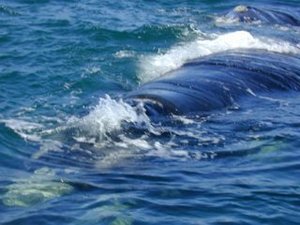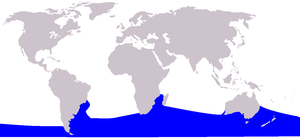Right whale
|
|
| Right Whales Conservation status: See text | ||||||||||||||||
|---|---|---|---|---|---|---|---|---|---|---|---|---|---|---|---|---|
 Southern Right Whale, Hermanus, South Africa | ||||||||||||||||
| Scientific classification | ||||||||||||||||
| ||||||||||||||||
| Species | ||||||||||||||||
|
Balaena mysticetus, Bowhead Whale | ||||||||||||||||
| Missing image Cetacea_range_map_Northern_Right_Whale.PNG Northern Right Whale range Northern Right Whale range | ||||||||||||||||
 Southern Right Whale range |
The right whales are marine mammals belonging to the family Balaenidae. There are four species in two genera: Eubalaena — three species of right whale (which are discussed below), and Balaena — the Bowhead Whale.
| Contents |
Taxonomy
The taxonomy of the right whales has long been controversial. The Bowhead Whale is clearly an individual species and has always been recognized as such. However, different authorities have disagreed over whether to categorize the other right whales as a single worldwide species, as two species (one found only in the northern hemisphere, the other found in the Southern Ocean), or as three species (splitting the northern species into Pacific and Atlantic populations). Small differences in the skull shape of northern and southern animals have tended to lend support to the two-species view. No group of right whales has been known to swim through warm equatorial waters to make contact with the other (sub)species and (inter)breed.
In recent years, genetic studies have provided clear evidence that the northern and southern populations have not interbred for between 3 million and 12 million years, confirming the status of the Southern Right Whale as a distinct species. More surprising has been the finding that the northern hemisphere Pacific and Atlantic populations are also distinct, and that the Pacific species (now known as the Pacific Northern Right Whale), is in fact more closely allied with the Southern Right Whale than with the Atlantic Northern Right Whale.
- ORDER CETACEA
- Suborder Mysticeti
- Family Balaenidae
- Atlantic Northern Right Whale, Eubalaena glacialis
- Pacific Northern Right Whale, Eubalaena japonica
- Southern Right Whale, Eubalaena australis
- Bowhead Whale, Balaena mysticetus
- Family Neobalaenidae: Pygmy Right Whale
- Family Balaenidae
- Suborder Odontoceti: 9 families
- Suborder Mysticeti
Other names
Due to their familiarity to whalers over a number of centuries the right whales have been given many names over the years. They reflect the fact that it is only in recent times that two species have been distinguished. In his novel Moby Dick, Herman Melville writes: "Among the fishermen, [the whale regularly hunted for oil] is indiscriminately designated by all the following titles: The Whale; the Greenland Whale; the Black Whale; the Great Whale; the True Whale; the Right Whale." In Portuguese, it is called " Baleia Franca ".
Physical description
Right whales are easily distinguished from other whales by the large number of callosities on their heads, a thick back without a dorsal fin, and a long dropping mouth that begins high above the eye and the arches round beneath it. The body of the whale is very dark grey or black with some white patches, particularly on the belly. Right whales are slow swimmers but highly acrobatic and frequently breach (jump clear of the sea surface), tail-slap and lobtail. Females reach sexual maturity at 6-12 years and breed every 3-5 years. Calves are approximately 1 metric ton (1.1025 tons) in weight and 2-4 meters (6.6-13.2 feet) in length. Adults may be between 11-18 meters (36-59 feet) in length and up to 80 metric tons (88.2 tons) in weight. Right whales have between 250 and 350 baleen plates on each side of the mouth.
Whaling
Right whales were named because whalers thought they were the 'right' whale to hunt, for several reasons. Most importantly, 40% of a right whale's body weight is blubber (which is of relatively low density). In consequence, unlike other whales, right whales float when they die, which made them easy to catch, even for men equipped only with frail wooden boats and hand-held harpoons. Hunting of right whales began as early as the 11th century in the Bay of Biscay, and continued throughout the centuries until the Atlantic population was commercially extinct. Exploitation of the Pacific and Southern Right Whales followed, and they too were on the brink of extinction by the early 1900s. A worldwide total ban on right whaling was agreed in 1937. Biscayan whalers introduced whaling for this species in Brazil in 1602, along the shores of Todos os Santos Bay (nowadays in Bahia State). From there, coastal whaling with land stations developed southwards to Santa catarina State, where the southernmost Brazilian whaling station was established in 1796, in Imbituba. This land station processed right whales until 1973, despite the worldwide ban. Today the whaling station is restored and the only Whale Museum of South America tells the story of right whales in Brazil, from whaling to whale watching.
Population and distribution
There are about 300 Atlantic Northern Right Whales, almost all living in the west North Atlantic, feeding in areas off the Canadian and US coasts. Sightings as far east as Iceland have been reported in 2003. A small population probably exists in the north Pacific. The Northern Right Whales are the most endangered of all large whales and two of the most endangered animals in the world. Based on current population density trends the species is predicted to become extinct within 200 years ([1] (http://news.bbc.co.uk/1/hi/sci/tech/3256406.stm)).
Southern Rights spend the summer months in the Southern Ocean feeding, probably close to Antarctica. Animals migrate north in winter for breeding and can be seen around the coasts of Chile, Argentina, Brazil, South Africa, Australia and New Zealand. The total population is estimated to be 7,000 to 8,000. Since hunting of the Southern Right Whale ceased, stocks have estimated to have grown by only 7% in 60 years. However the IUCN lists the species as lower risk; conservation dependent in their Red List of Threatened Species. In Brazil, more than 300 individuals have been cataloged through photo-identification (using their distinctive head callosities) by the Brazilian Right Whale Project, maintained jointly by PETROBRAS (the Brazilian state-owned oil company) and the International Wildlife Coalition. The State of Santa Catarina hosts a concentration of breeding and calving right whales from June to November, and females from this population are also known to calve off Argentinian Patagonia.
Hearing
A report published in the Proceedings of the Royal Society B in December 2003 suggested that Northern Rights responded rapidly on hearing sounds similar to police sirens. On hearing the sounds they moved rapidly to the surface. The research was of particular interest because it is known that Northern Rights ignore most sounds, including those of approaching boats.
Whale watching
Southern Right Whales have made Hermanus, South Africa one of the world centers for whale watching. During the winter months (July-October) Southern Right Whales come so close to the Cape shoreline that visitors can watch whales from their (deliberately placed) hotels. The town employs a 'whale crier' (c.f. town crier) to walk through the town announcing where whales have been seen. Southern Rights can also be watched at other winter breeding grounds. In Brazil, Imbituba township in the State of Santa Catarina has been recognized as the National Right Whale Capital and holds annual Right Whale Week celebrations in September, when mothers and calves are more often seen. In Argentina, Peninsula Valdés in Patagonia hosts in winter the largest breeding population of the species, with more than 2,000 animals catalogued by the Whales Conservation Institute.
Conservation
The particular vulnerability of the Northern Right Whale, which migrates through some of the world's busiest shipping lanes whilst journeying off the east coast of the United States, to collisions with ships led the National Oceanic and Atmospheric Administration to propose new guidelines for captains of vessels in the area in June 2004. The guidelines, currently open to public consultation, proposed a raft of measures restricting where ships could travel, and at what speed they can move in common right whale feeding areas.
The Southern Right Whale is protected in the jurisdictional waters of all countries with known breeding populations (Argentina, Australia, Brazil, Chile, New Zealand, South Africa and Uruguay). In Brazil, a federal Environmental Protection Area encompassing some 1,560 square kilometres (and 130 km of coastline) in Santa Catarina State has been established in 2000 to protect the species' main breeding grounds in Brazil and promote regulated whale watching. More information on Brazilian right whales is available in Portuguese at www.baleiafranca.org.br .
Source: PRNewswire report through Yahoo! : [2] (http://biz.yahoo.com/prnews/040601/dctu045_1.html)
References
- Encyclopedia of Marine Mammals, editors Perrin, Wursig and Thewissen, ISBN 0125513402.
- Collins Gem : Whales and Dolphins, ISBN 0004722736.
- Whales, Dolphins and Porpoises, Mark Carwardine, ISBN 0751327816.
- Northern Right Whales respond to emergency sirens (http://news.bbc.co.uk/1/hi/sci/tech/3256406.stm)
- Gaines, C., Hare, M., Beck, S., & Rosenbaum, H. (2005) (http://www.journals.royalsoc.ac.uk/openurl.asp?genre=article&id=doi:10.1098/rspb.2004.2895). Nuclear markers confirm taxonomic status and relationships among highly endangered and closely related right whale species. Proceedings of the Royal Society of London Series B, 272, 533-542.
Related topics
de:Glattwale eo:Vera Baleno nl:Noordkaper pl:Wale gładkoskóre pt:Baleia franca sv:Rätvalar
